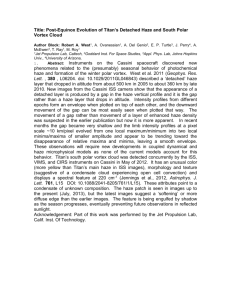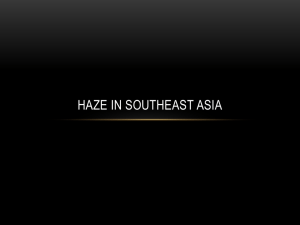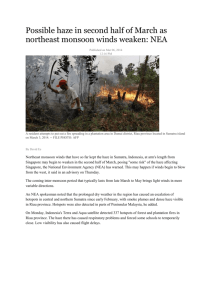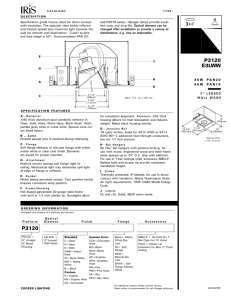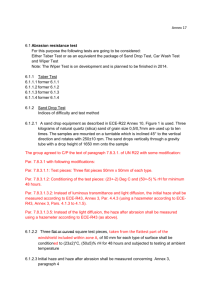www.ijecs.in International Journal Of Engineering And Computer Science ISSN:2319-7242
advertisement
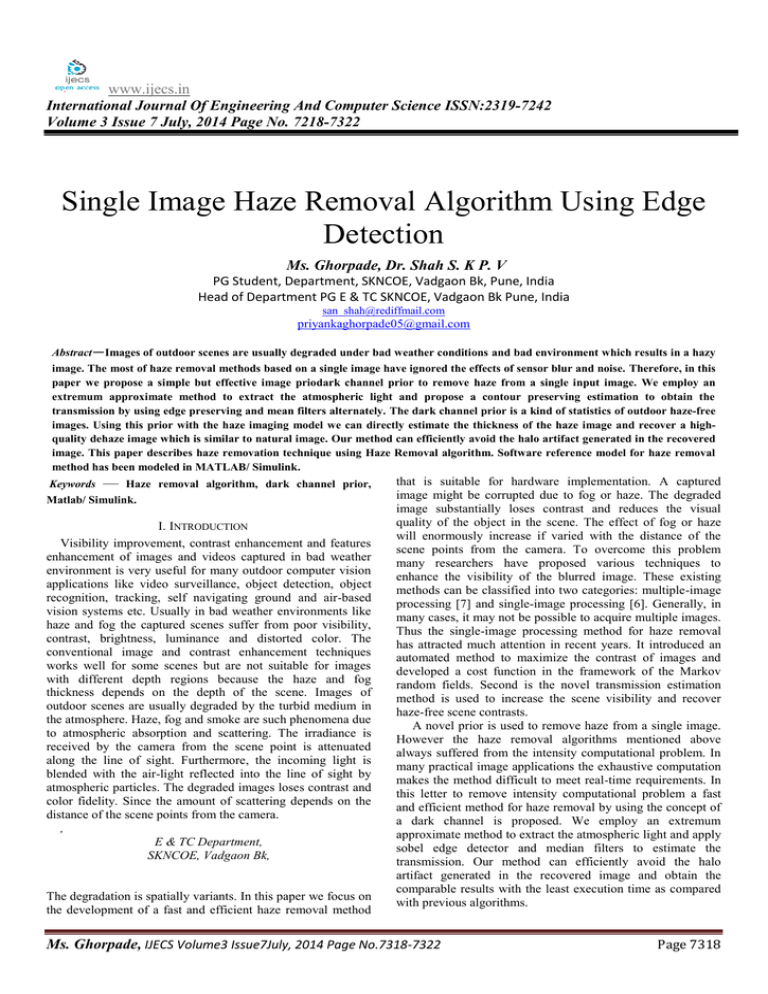
www.ijecs.in International Journal Of Engineering And Computer Science ISSN:2319-7242 Volume 3 Issue 7 July, 2014 Page No. 7218-7322 Single Image Haze Removal Algorithm Using Edge Detection Ms. Ghorpade, Dr. Shah S. K P. V PG Student, Department, SKNCOE, Vadgaon Bk, Pune, India Head of Department PG E & TC SKNCOE, Vadgaon Bk Pune, India san_shah@rediffmail.com priyankaghorpade05@gmail.com Abstract—Images of outdoor scenes are usually degraded under bad weather conditions and bad environment which results in a hazy image. The most of haze removal methods based on a single image have ignored the effects of sensor blur and noise. Therefore, in this paper we propose a simple but effective image priodark channel prior to remove haze from a single input image. We employ an extremum approximate method to extract the atmospheric light and propose a contour preserving estimation to obtain the transmission by using edge preserving and mean filters alternately. The dark channel prior is a kind of statistics of outdoor haze-free images. Using this prior with the haze imaging model we can directly estimate the thickness of the haze image and recover a highquality dehaze image which is similar to natural image. Our method can efficiently avoid the halo artifact generated in the recovered image. This paper describes haze removation technique using Haze Removal algorithm. Software reference model for haze removal method has been modeled in MATLAB/ Simulink. Keywords — Haze removal algorithm, dark channel prior, Matlab/ Simulink. I. INTRODUCTION Visibility improvement, contrast enhancement and features enhancement of images and videos captured in bad weather environment is very useful for many outdoor computer vision applications like video surveillance, object detection, object recognition, tracking, self navigating ground and air-based vision systems etc. Usually in bad weather environments like haze and fog the captured scenes suffer from poor visibility, contrast, brightness, luminance and distorted color. The conventional image and contrast enhancement techniques works well for some scenes but are not suitable for images with different depth regions because the haze and fog thickness depends on the depth of the scene. Images of outdoor scenes are usually degraded by the turbid medium in the atmosphere. Haze, fog and smoke are such phenomena due to atmospheric absorption and scattering. The irradiance is received by the camera from the scene point is attenuated along the line of sight. Furthermore, the incoming light is blended with the air-light reflected into the line of sight by atmospheric particles. The degraded images loses contrast and color fidelity. Since the amount of scattering depends on the distance of the scene points from the camera. , E & TC Department, SKNCOE, Vadgaon Bk, The degradation is spatially variants. In this paper we focus on the development of a fast and efficient haze removal method that is suitable for hardware implementation. A captured image might be corrupted due to fog or haze. The degraded image substantially loses contrast and reduces the visual quality of the object in the scene. The effect of fog or haze will enormously increase if varied with the distance of the scene points from the camera. To overcome this problem many researchers have proposed various techniques to enhance the visibility of the blurred image. These existing methods can be classified into two categories: multiple-image processing [7] and single-image processing [6]. Generally, in many cases, it may not be possible to acquire multiple images. Thus the single-image processing method for haze removal has attracted much attention in recent years. It introduced an automated method to maximize the contrast of images and developed a cost function in the framework of the Markov random fields. Second is the novel transmission estimation method is used to increase the scene visibility and recover haze-free scene contrasts. A novel prior is used to remove haze from a single image. However the haze removal algorithms mentioned above always suffered from the intensity computational problem. In many practical image applications the exhaustive computation makes the method difficult to meet real-time requirements. In this letter to remove intensity computational problem a fast and efficient method for haze removal by using the concept of a dark channel is proposed. We employ an extremum approximate method to extract the atmospheric light and apply sobel edge detector and median filters to estimate the transmission. Our method can efficiently avoid the halo artifact generated in the recovered image and obtain the comparable results with the least execution time as compared with previous algorithms. Ms. Ghorpade, IJECS Volume3 Issue7July, 2014 Page No.7318-7322 Page 7318 II. LITERATURE SURVEY There are many haze removation methods that can be used to produce high-quality, noise free dehaze images from a single image with dark channel prior. These methods are classified into image segmentation and image restoration techniques. Images of outdoor scenes are often degraded with fog, mist or haze. In surveillance and transportation area haze removation is important task. They need to carry out meaningful scene analysis, extract useful information and detect image features. In bad weather conditions the observed light is absorbed and scattered by turbid mediums such as atmosphere particles or raindrops. This model is also employed in many haze removal approaches and is expressed as, I(x) = J(x) t(x) + A (1 − t(x)) (1) Where, I is the haze image on the three R, G, B color channels, J is the scene without haze, t is the transmission coefficient to describe the percentage of light that can penetrate the haze, and A is the atmospheric light. Using this atmospheric scattering model to recover the scene J, the main challenge of haze removal is to estimate the atmospheric light A and the transmission t from the source image I properly. The dark channel prior is based on the following observation. On haze-free outdoor images in which most of the non-sky patches contain at least one color channel has very low intensity at some pixels. By using this it requires some extensive and complex computations, such as huge matrix multiplication or division, sort, exponent, and floating point operations. In addition this chapter investigates some different haze removal methods like multiple image scheme, single image with depth image scheme and single image scheme. A. Haze Removal methods There are many haze removation methods that can be used to produce high-quality, noise free dehaze images from a single image with dark channel prior. These methods are classified into image segmentation, image enhancement and image restoration techniques. 1) Segmentation of image: Image segmentation is the process of partitioning a digital image into multiple segments. The goal of segmentation is to simplify and/or change the representation of an image into something that is more meaningful and easier to analyze. Image segmentation mostly used to locate objects and boundaries in images. Actually image segmentation is the process of assigning a label to every pixel in an image such that pixels with the same label share certain visual characteristics. 2) Image Restoration: Image restoration is the operation of taking a corrupted/noisy image and estimating the clean original image. Corruption may come in many forms such as motion blur, noise, and camera mis-focus image restoration is different from image enhancement in that the latter is designed to emphasize features of the image that make the image more pleasing to the observer, but not necessarily to produce realistic data from a scientific point of view. Image enhancement techniques provided by "Imaging packages" use no a priori model of the process that created the image. With image enhancement noise can effectively be removed by sacrificing some resolution but this is not acceptable in many applications. The resolution in the z-direction is bad as it is seen in a Fluorescence Microscope. But image restoration techniques recover the haze image with better quality and brightness. More advanced image processing techniques must be applied to recover the object. Increasing resolution especially in the axial direction removes noise and increasing contrast. B. Haze Removal using dark channel prior:Recently single image haze removal has made significant progresses. The success of these methods lies on using stronger priors or assumptions. The different researcher’s can use different methods to remove haze. Tang can use soft matting algorithm to remove haze. [04] But it may fail when this model is physically invalid and the constant-air-light assumption may be unsuitable when the sunlight is very influential. Tarel uses image restoration technique to recover the haze. [05] Fattal [05] estimates the albedo of the scene and the medium transmission under the assumption that the transmission and the surface shading are locally uncorrelated. This approach is physically sound and can produce impressive results. However it can’t handle dark hazy images as well as it may fail in the cases where the assumption is broken. In this project we propose a novel prior dark channel prior for single image haze removal. The dark channel prior is based on the statistics of outdoor haze-free images. We find that in most of the local regions which do not cover the sky, some pixels (called dark pixels) very often have very low intensity in at least one color (R,G, &B) channel. In hazy images the intensity of these dark pixels in that channel is mainly contributed by the air-light. Therefore the dark pixels can directly provide an accurate estimation of the haze transmission. Combining a haze imaging model and an edge detection method we recover a high-quality haze free image and produce a good depth map. III. PROPOSED SYSTEM In this paper Haze removal is described using single image with dark channel prior. This technique basically takes source image i.e. haze image from the same scene or different scene under different weather conditions to generate dehaze image.[1] A. Software Design For dehaze image input images preferably of the same size are taken. A captured image might be corrupted due to fog or haze. The degraded image substantially loses contrast and reduces the visual quality of the object in the scene. The effect of fog or haze will enormously increase if varied with the distance of the scene points from the camera. In equation 1 I is the haze image on the three RGB colour channels, J is the scene without haze t is the transmission coefficient to describe the percentage of light that can penetrate the haze, and A is the atmospheric light. Using this atmospheric scattering model to recover the scene J the main challenge of haze removal is to estimate the atmospheric light A and the transmission t from the source image I properly. B. The three-stage haze removal algorithm The proposed algorithm has three stages as shown in Figure1. In the first stage a edge detection used to detect the contour of edges in the images and non-local median filter is used to preprocess the degraded image. In the second stage the Ms. Ghorpade, IJECS Volume3 Issue7July, 2014 Page No.7318-7322 Page 7319 dark channel prior method is used to estimate the transmission and the atmospheric light. In the third stage a regularized method combining the transmission is used to obtain the final result. low and close to zero. Airlight is estimated by picking up the pixels of the image corresponding to the 0.1% brightest pixels in the dark channel and then choosing the one with maximum intensity. C. The preprocessing methods The non-local median filter] is a simple yet efficient approach for denoising. Thus considering noise in a hazy image it is selected as the preprocessing for denoising in the first stage. The key idea of the non-local median filter is based on similar patches. It restores the current pixel intensity using the pixels in the similar neighbors. Thus we propose a more efficient and low-complexity haze removal algorithm that can obtain good results. The dehaze images are obtained by using haze removal algorithm with the help of Simulink. F. Dark Channel The dark channel prior is based on the following observation: On haze-free outdoor images in which most of the non-sky patches at least one colour channel has very low intensity at some pixels. In other words the minimum intensity in such a patch should have a very low value. Formally for an image Idark we define, Haze Image Edge Detector Idark(x) = (2) Where Ω(x) is a local square window of the minimum filter centered at x coordinate. Ic means the R, G, B colour channel of the input image I. Then, the atmospheric light is estimated from the top 0.1% brightest pixels in the dark channel Idark. According to (1) and (2), the transmission can be computed as, t (x) = 1- (3) Median Filter Atmospheric Light Estimation Transmission Estimation Scene Recovery Where, ω is used to keep a small amount of haze. Ac is R, G and B color channel of the atmospheric light. To avoid the halo artifact generated in the recovered scene, the soft matting method is applied to optimize the transmission. To reduce the running time of this procedure, and also presented a guided filter instead of the soft matting to refine the transmission effectively. Avoiding the noise generated in the recovered scene, a lower bound t0 is used to restrict t(x). Finally, the scene J can be calculated as, (4) Dehaze Image Fig. 1 Flow diagram of proposed Haze Removal Algorithm system D. Edge detection By this method, our approach can preserve edges in detail areas, while still permitting de-hazing in smooth areas and minimizing the halo artifact. Here sobel edge detection is used to finds edges of objects in images. Edge Detector returns an edge detection System object H that finds edges in an input image. In median filter the median value is less sensitive than the mean to extreme values. As a result the Median Filter block can remove salt-and-pepper noise from an image without significantly reducing the sharpness of the image. G. Transmission Estimation Estimated transmission map is calculated by subtracting the recomputed dark channel after removing the atmospheric lighting from the original image. H. Scene Recovery Once the atmospheric light and the transmission are estimated the scene J can be recovered by, (5) I. Simulink Model of Haze Removal Method E. Atmospheric light estimation In most of the non-sky patches, at least one color channel has very low intensity at some pixels whose intensity is very Ms. Ghorpade, IJECS Volume3 Issue7July, 2014 Page No.7318-7322 Page 7320 Fig. 2 Simulink model of proposed Haze Removal system In this Simulink model sobel edge detector used to detect the edges in the images and median filter sharpened the stronger edges. This model requires less computational time than other methods. display the dehaze image. Haze removation results are obtained by running the Simulink model with the help of haze removal algorithm. The input image of temple is in . jpg format whose size is 300×400 taken as input images for dehazing. IV. EXPERIMENTAL RESULTS In our experiment we use the Haze algorithm whose complexity is linear to image size. A demonstration system has been set up for testing the implementation of design in real-time on the Matlab and Simulink software. The haze image i.e. stored haze image is taken first. If the haze is dense the color is faint and the variance is not high enough for Fattal’s method to reliably estimate the transmission. Since only parts of transmission can be reliably recovered, some of these regions are too dark and some hazes are not removed. (a) (b) Fig. 4 a) Edge detected image b) Filtered image Fig. 5 Dehaze image (a) (b) Fig. 3 a) Haze image b) Dark channel image Fig.3,4 and 5 shows the input test image, darkchannel image, edge detection image, filtering image and finally Fig. 3(a) is the input image that is the haze image which contains clouds. The dark channel prior becomes better for a larger patch size because the probability that a patch contains a dark pixel is increased. The larger the patch size the darker the dark channel. In Fig. 3(b) contains patch size 15 in this Ms. Ghorpade, IJECS Volume3 Issue7July, 2014 Page No.7318-7322 Page 7321 figure halos near depth edges may become stronger. Here sobel edge detection is used to finds edges of objects in images. Edge Detector returns an edge detection system object, H that finds edges in an input image. In median filter the median value is less sensitive than the mean to extreme values. As a result as shown in Fig.4(a), the Median Filter block can remove salt-and-pepper noise from an image which is shown in Fig.4(b) without significantly reducing the sharpness of the image and finally get the dehaze image shown in Fig 5 with minimum halo artifact. On the contrary, our approach works well for both regions and generate comparable results from a single image without any geometric information as shown in Fig.3, Fig.4. and Fig.5. Fig. 3(a) and Fig.5 shows the haze image and dehaze image. The proposed method requires less computational time compared with other methods. [10] S. G. Narasimhan and S. K. Nayar, ―Removing weather effects from monochrome images,‖ in Proc. IEEE Conf. Comput. Vision Pattern Recognit., Dec. 2001, pp. II-186– II-193. [11] Y. Y. Schechner, S. G. Narasimhan, and S. K. Nayar, ―Polarization based vision through haze,‖ Appl. Opt., vol. 42, no. 3, pp. 511–525, Jan. 2003. [12] S. Shwartz, E. Namer, and Y. Y. Schechner, ―Blind haze separation,‖ in Proc. IEEE Conf. Comput. Vision Pattern Recognit., Jun. 2006, pp. 1984–1991. [13] J. P. Oakley and H. Bu, ―Correction of simple contrast loss in color images,‖ IEEE Trans. Image Process., vol. 16, no. 2, pp. 511–522, Feb. 2007. V. CONCLUSION In this work, Haze Removal Algorithm using a Matlab and Simulink platform has been described. Our method by using edge detection and filtering can efficiently avoid the halo artifact generated in the images with least execution time. It gives better result than the others. The resultant dehaze image is more reliable, clear and more accurate and intelligible. REFERENCES [1] Xia Lan1, Liangpei Zhang2, Huanfeng Shen3*, Qiangqiang Yuan4 and Huifang Li2 Lan et al. ―Single image haze removal considering sensor blur and noise‖,EURASIP Journal on Advances in Signal Processing 2013 [2] E Matlin, P Milanfar, ―Removal of haze and noise from a single image,‖ in SPIE Conference on Computational Imaging. SPIE Proceedings, vol. 8296 SPIE, Bellingham, 2012 [3] K. He, J. Sun, and X. Tang, ―Single image haze removal using dark channel prior,‖ IEEE Trans. Pattern Anal. Mach. Intell., vol. 33, no. 12, pp. 2341–2353, Dec. 2011. [4] K. He, J. Sun, and X. Tang, ―Guided image filtering,‖ in Proc. 11th Eur. Conf. Comput. Vis. Part I, pp. 1– 14.,2010. [5] J.-P. Tarel and N. Hautière, ―Fast visibility restoration from a single color or gray level image,‖ in Proc. IEEE Int. Conf. Comput. Vision, pp. 2201–2208,Sep. 2009. [6] N. Hauti`ere, J.-P. Tarel, D. Aubert, and E. Dumont. Blind contrast enhancement assessment by gradient ratioing at visible edgese. Image Analysis & Stereology Journal, 27(2):87–95, june 2008. [7] S. Perreault and P. Hebert. Median filtering in constant time. IEEE Transactions on Image Processing, 16(9):2389–2394, september 2007. [8] R. T. Tan, ―Visibility in bad weather from a single image,‖ in Proc. IEEE Conf. Comput. Vision Pattern Recognit., pp. 1–8,Jun. 2008. [9] S. G. Narasimhan and S. K. Nayar, ―Vision and the atmosphere,‖ Int. J. Comput. Vision, vol. 48, no. 3, pp. 233–254, Jul. 2002. Ms. Ghorpade, IJECS Volume3 Issue7July, 2014 Page No.7318-7322 Page 7322 www.ijecs.in International Journal Of Engineering And Computer Science ISSN:2319-7242 Volume 3 Issue 7 July, 2014 Page No. 7218-7322 Ms. Ghorpade, IJECS Volume3 Issue7July, 2014 Page No.7318-7322 Page 7323

